开发者分享《Puzzle Craft》制作经历和过程
作者:Babak Kaveh
《Puzzle Craft》是由Ars Thanea Games所开发,Chillingo发行的跨类型益智/城镇建造游戏。游戏获得了那些喜欢上瘾的游戏玩法与低调的应用内部购买模式的公众们很高的评价与反响。
本篇文章将回顾这款游戏的制作过程,并分享一些有帮助的观点与趣事。
幕后
Ars Thanea Games是一家小型的独立游戏开发商,是广告代理商兼制作工作室Ars Thanea旗下的一员。
该开发商于2011年7月开始投入制作《Puzzle Craft》,并在2012年8月16日正式发行这款游戏,大约经历了1年多的时间,核心团队中只有4名成员,有些工作是通过外包完成的。
我们在制作原理时先从简单的原型创造与迭代开始,致力于某些游戏理念,并围绕着这些理念而扩展,不断添加一些新元素。我将在本文中我列举一些有趣的例子去分析这一过程。
我们使用Cocos2d进行游戏编程。我们同样也创造了一个工具箱去定义游戏玩法并编辑村庄屏幕。作为一个小团队,我们发现区分程序员与设计师的工作非常重要。使用工具箱不仅能够让我们安心测试游戏玩法,并进行反复平衡,同时也能让程序员专注于新功能的优化。在游戏编辑器中我们定义了所有价格,谜题参数,更新,并基于代码而使用一系列行动对此进行描述。我们将数据保存在XML文件中,从而让我们可以无需再次创造代码便能够将其下载到游戏中并测试新参数。
村庄编辑器也是另外一种定制工具。我们使用这一工具去定义村庄屏幕上所有视觉元素,包括树木,建筑,道路等的设置。这两种编辑器都是基于Flash进行创造。
塑造基本理念
一开始我们是围绕着两个基本理念:我们想要创造一款有关玩家建造,创造并关心某些事物的游戏,而不是在游戏中进行破坏;我们同样也想创造一款带有真实游戏玩法的游戏。
在明确了核心理念后,我们决定创造一款基于城镇建造且带有谜题元素的模拟游戏。我们希望能够突显于其它城镇建造游戏中,并希望玩家能在此做出一些建设性的行动,而不只是点击与等待。通过解决谜题收集资源就很棒,也很有趣。所以基本的游戏玩法便诞生了,即当玩家想要一栋新建筑时,便可以通过解决谜题去获得更多所需资源,然后再进行建造。这么做将带给玩家满足感,并会激励他们建造更多新建筑。一开始我们只创造了一个简单的原型,一些草稿式图像以及简陋的代码。但当我们决定围绕着这一理念而创造游戏时,它的确表现得很出色。
随后我们逐步开始添加更多深层次的新元素于游戏玩法中。对我们来说首个挑战便是定义农场与矿藏之间的区别——农场更加有机,平和,而矿藏则更加工业化也更有挑战。这也是为什么每个访问农场的玩家都能持续一年时间(随着季节变迁),但是当玩家进入矿藏时,他们必须使用自己所收集的食物,这里的供给物非常有限,玩家只能尽力去挖掘。
测试玩家所提出的首个反馈表示,他们需要一些即时奖励,让他们能够改变谜题板上的情境。而关于该添加多少收集层面,添加哪些新资源,奖励层面的链条该多长等等问题还是存在着争议。让玩家做决定似乎是个不错的主意。
因此《Puzzle Craft》的三个游戏玩法基础为:
1.工具,作为一次性奖励将给予玩家更多控制权。
2.工人,改变砖块变成资源以及长链条变成奖励砖块的比例。
3.建筑,将最后修改内容引进游戏玩法中。
关于建筑,我们创造了一张巨大的电子表格以记录游戏每次改变的元素,并基于该表格去考虑任何可行的建筑。
同时我们还尝试并优化了谜题机制。平衡像爆炸气,老鼠,狼等干扰物,并统一所有机制:一长串泥土,草地,树木都不能提供任何奖励层面,所以我们进行了修改,增强了矿藏谜题屏幕的核心主题(让玩家不使用工具便能收集泥土的设置能够增强挑战性)。
基于少量机制,我们开始创建游戏,并花了几个月时间不断修改并迭代所有更新内容和价格,最终创造出一个深层次且让人上瘾的游戏玩法。
定价
一开始我们想将《Puzzle Craft》设定为付费下载游戏,价格大约为2美元或3美元。当完成原型创建时,我们将其呈献给发行商Chillingo,他们认为游戏更适合免费模式。
我们花了一个多月的时间去测试游戏,并最终做出了一些有趣的改变:
在原型中,每个建筑能够提高你的“人口数”,而为了获得更强大的建筑你就需要达到足够的人口数。但是这与你雇佣的工人没有任何关系,并且很有可能让玩家感到困惑。
我们最终将这一机制改成大家所熟悉的经验值/级别系统。并添加更多深度内容,如玩家不仅可以通过获得新建筑而增加经验值,还可以使用工具,收集资源,并创造更长的链条去提高经验值。这时候,玩家的技巧也会变得更加重要。
我们添加了访问农场的时间障碍。玩家可以凭借足够的种子袋进入农场,但是当他们用光了种子后就不得不耐心等待,或花钱购买更多种子袋。
我们提高了建筑和工具所需的资源数,并决定雇佣工人的价格随着工人类型的改变而改变。一开始这种改变是受业务所驱动,但后来我们注意到游戏乐趣出现了显著的提高。
添加时间奖励:建造工具和资源以及纳税资金。
我们想出了一些能够帮助玩家获得游戏内部货币的方法,如在矿藏中的额外行动,拯救农场,或购买建筑等。
后来我们意识到,为了开发一款赚钱的免费游戏,我们必须让玩家等待建筑的建造过程(如果不想等待就花钱跳过),并添加第二种货币(只能用于应用内部购买)。但是说实话,这种想法糟糕透了。如果我们添加了这些玩法游戏将变得很无聊。所以我们最终决定放弃免费模式,并基于应用内部购买而创造一款低准入游戏(游戏邦注:售价为0.99美元)。
就像你所看到的,我们开始测试一些抽象的符号,并将这些符号改成一袋袋种子,然后才放弃这一理念。玩家仍然需要为工人花钱,但是价格已经设置好了,并且他们不需要做出任何等待。实际上,花钱进入农场的真正目标是为了让货币变得更有价值——当你需要不断使用货币时,你便能感受到它们的实用性,并乐意去挣取更多货币。
我们删除了所有时间障碍以及可能让玩家感到挫败的内容,因为它们并不有趣。但是我们决定留下时间奖励,因为它们很有趣。然后我们再次平衡了整款游戏,从而确保玩家可以无需在应用内部购买中花钱便能完成游戏。
回想起来,我们真的做出了明智的决定。最终我们创造出了理想中的游戏——能让玩家放松,并专注于游戏玩法而不是无尽地等待。
塑造外观
《Puzzle Craft》设计中最有趣的便是视觉效果的迭代。让我们着眼于游戏一些关键元素的演变。
农场
最开始游戏原型包含一些浆果(没有胡萝卜),在冬天会出现深深的积雪,并且只有兔子而不是老鼠。玩家可以手动改变季节,我们也仍在寻找最完美的西红柿——那时候还不知道我们所需要的其实是苹果。
新的外观更棒,并也包含了最后的动物和植物,但我们仍然进行了多次迭代去优化每一个元素:资源,层面(是否要带黑色轮廓?),冬天的树,日历以及时间进度条。
矿藏
一开始是基于黑暗效果——带有非功能式资源指标,但是在黑暗背景中就看不到煤矿了,并且我们不知道如何绘制铁矿石。
我们花了一些时间才让整个画面比较接近印象中的深度矿藏主题。最后我们添加了单独的泥土块,因为我们认为好看的泥土并不符合玩家的直觉。
村庄
在我们最初的原型中,村庄是静态的——新建筑会出现于预先设定好的场景中,而玩家能够做的便是决定自己想要建造哪个建筑,然后观察村庄的变化。一开始我们先绘制了一些草图,但却发现很难将其全部整合到一个屏幕内(游戏邦注:就像是访问矿藏,滑动屏幕,检查村庄,滑动屏幕,前往农场这样的过程)。
如此设定的结果便是不仅使用起来相当笨拙,而且房子会显得很小,所以我们决定专注于伪异构视图,并在平面建筑基础上添加一些深度。我们对结果感到非常满意,并开始朝着最终图像效果进行完善。
当然,我们很清楚玩家想要自己决定在哪里放置建筑,所以我们添加了放置机制。我们投入了一些时间,并利用了剪纸原型而找到在地图和建筑(作为静态图像)上添加一定自由度的方法。而最关键的还是忘记标准网格方法,并选择手动放置槽。最后的挑战便是如何与城堡搭配起来——解决方法便是放弃这种搭配。当城堡跨越屏幕界限时,玩家便足以为此感到满足了。
界面
设计游戏是一回事,将设计传达给玩家则是另外一回事。在《Puzzle Craft》玩家需要能够收集砖块,购买新建筑,工具和功能,并检查与销售资源,进行应用内部购买,为矿藏准备物资等等。他们同时还需要理解游戏中的所有机制。
最后的界面非常简单,但是第一个方法却非常复杂。
一开始各种类型的升级都是基于一个按键,然后我们将其分散到一些非直觉型标签上,最终我们是以一个独立的按键和单独的标签完成各种类型的升级(包括建筑,工人与道具)。
移除标签让我们能够利用所有重要信息而设计一个完整的上方信息栏。
一开始我们打算将物资作为游戏循环的主要部分,并设置了一个独立屏幕去完成这一过程。
但是该屏幕却未能呈现出预期的乐趣,所以我们决定添加更多图像。
直到我们意识到最佳选择是将屏幕向下移并使用一个弹出窗口(能够完善玩家的体验)时,我们便能在下方信息栏上拥有更多空间(我们需要将之前提到的标签整合到不同按键上)。
我们同样需要将来自单独屏幕上的资源汇总移至一个可行的标签上(我们还需要留意铁,银,金条图标的改变)。
但是最复杂的部分便是告知玩家游戏规则的运行。
第一种方法便是详细但却费解的统计/关系屏幕。我们将其分为市政厅屏幕(游戏邦注:在发行时仍存在着)以及一个华丽,精细,并且仍让人费解的关系屏幕。
在经过多天的争议与头脑风暴后,我们抛弃了这一屏幕而选择在适当位置以及合适时刻呈献给玩家相同的信息。最终证明这种做法是对的。
教程
当我们意识到不知如何向玩家解释所有机制时,游戏基本算完成了。我们当然不可能逐个向玩家进行描述。
我们先创造了一个巨大的弹出窗口,并带有许多文本内容。可想而知,这一做法并不可行,没有人愿意去阅读这些文本,每个人都会直接跳过弹出窗口。虽然动画影像很棒,但是我们却没有足够的世界或空间去创造动画教程。
最终我们呈现了一部分动画教程,并缩减了弹出窗口的规格。从而所有信息都能通过图像,并借由玩家的村民们进行传达。
如此的改变让更多人愿意去阅读文本内容(并加深了玩家与虚构的村民之间的关系)。但是最有影响力的教程工具还是指向下一个互动元素的跳跃式箭头。
在致力于教程创造的某一时时刻,我们意识到需要向玩家解释许多内容:砖块也是资源的组成部分,玩家将因为创造出更长的链条儿获得奖励,工人对游戏有何影响,老鼠能做什么等等。
我们所选择的解决方法便是在最低阶段(还有长链条,工人,工具,自由移动以及市场)开始游戏玩法,并创造能够引进新游戏元素的建筑。这真的是一次巨大的突破——我们赋予玩家改变游戏规则的能力,而玩家也喜欢这种能力。
除此之外,我们还留下了一部分游戏机制和关系。如此能让玩家自己去探索并分析,然后独自找出最佳组合或策略。许多玩家与我们一样,也喜欢发现的乐趣。
主菜单
最初我们创造了一个较无聊的主菜单,但是之后又创造了一个非常棒的加载菜单,所以我们决定混合这两个菜单,经过调色后最终获得了一个非常好看的主菜单。
logo
在致力于《Puzzle Craft》的logo时,我们决定专注于游戏的两个主要元素:农作和采矿。我们是在最初设计时便开始探索这一理念。
我们真的很喜欢这个3D版本的logo,但是最后还是决定简化它,以2D模式去呈现这些字母。效果如下:
图标
一开始我们创造了一些简单的占位符图标。
然后我们准备了一些草图打算与发行商Chillingo进行讨论。
然后我们改善了这些图标。
并准备了更多图标,这次我们专注于呈现游戏玩法。
Chillingo准备他们的主题。
之后我们尝试了一个完全不同的方法。
最后,即一个月后,我们基本上完成了《Puzzle Craft》的图标创造。
在这个只有4个人的团队中(同时还有部分外包),我们的整个开发过程共经历了12个多月的时间。
(本文为游戏邦/gamerboom.com编译,拒绝任何不保留版权的转载,如需转载请联系:游戏邦)
The Evolution of Puzzle Craft
by Artur Ganszyniec
Puzzle Craft is a cross-genre puzzle/town building game developed by Ars Thanea Games and published by Chillingo. The game got great reviews, and a great response form the public, who loved the addictive gameplay, and the unobtrusive in-app purchase model.
In this article we would like to look back at the production of the game and share with you some insights and anecdotes.
Behind the Scenes
Ars Thanea Games is a small, independent game developer, and a part of an advertising agency and production studio Ars Thanea.
The game was published on the 16th of August, 2012. The development of Puzzle Craft started in July 2011 and took almost one year, with a core team of four people, along with some outsourcing.
Our production philosophy was to start with simple prototypes and iterate, working on the ideas, expanding them and adding new elements. Later in the text we will analyze the process on several interesting examples.
The final version of Puzzle Craft.
The game was coded using Cocos2d. We also created a toolset for defining the gameplay and editing the village screen, as in such a small team we found it critical to separate the programmer’s work from the designer’s tasks. With the toolset we could test the gameplay and balance over and over, while the programmer focused on new features optimization etc. In the gameplay editor we defined all prices, puzzle parameters, and upgrades describing them with a set of actions defined in the code. The data was saved to an XML file, which we could download to the game and test the new parameters without the need to rebuild the code.
Click for larger version
The other custom-made tool was the village editor. We used it to define all the visual aspects of our village screen — the placement of trees, the placement and parameters of building slots, the roads the villagers used etc. Both editors were made in Flash.
Shaping of the Basic Idea
We started with two base ideas: we wanted to make a game about building, creating, and caring about stuff, rather than a game about destroying; we also wanted to make a game with some actual gameplay.
Going after the building/creating core idea, we decided to make a town-building simulation, and the engaging gameplay core idea solidified in the puzzle element. We wanted to stand out form the other town-building games, and wanted the players to actually do something constructive, rather that just click and wait. Collecting resources by solving puzzles seemed constructive enough, and fun enough. So the basic gameplay cycle was born — you want a new building, so solve puzzles until you have the resources you need; then you build the building, feel satisfied, and want to build another new building. At the beginning there was a simple prototype, with doodle graphics and duct-taped code. And it played so well that we decided to go for it.
Step by step, we started adding depth and new elements to the gameplay. The first challenge was to define the difference between the farm and the mine — the goal was that the farm felt organic and peaceful, while the mine challenging and industrial. That is why every visit on the farm lasts for one year, and as you play the seasons change, while to go enter the mine, you have to use some of the food you gathered and the supplies are the only limit, you dig as deep as you can.
The first feedback from test players showed that there was a need for some kind of instant bonuses, that would allow them to change the situation on puzzle boards. There were also some disagreements on how many collected tiles should add you a new resource and how long a chain should add a bonus tile. Letting the players decide seemed like a good idea.
Thus the three cornerstones of Puzzle Craft gameplay were defined:
1. Tools acting as one-time bonuses giving more control over the board;
2. Workers, changing the tile-to-resource and chain-length-to-bonus-tile ratios;
3. Buildings, introducing lasting changes to the gameplay.
With the buildings, we have actually made a huge spreadsheet listing every changeable element of our game and basing on that list we started thinking on possible buildings.
At the same time we were playing and polishing the puzzle mechanisms. Distractions like the explosive gas, rats, and wolves were balanced and all mechanisms unified: at first long chains of dirt, grass and trees gave you no bonus tiles — then we changed that, strengthening in the process the core themes of the mine puzzle screen (gathering dirt without tools heightens the risk).
Basing on a small number of mechanisms, we started building up the game, and after several months of constant testing and re-iterating of all the upgrades and prices ended with a quite deep and addictive gameplay.
Thinking About Money
The first idea was to publish Puzzle Craft as a typical pay-for-download game, at a price of about $2 or 3. When first prototype was finished and we showed it to our publisher, Chillingo, they put forward an idea: the game would do nicely as a free-to-play title.
Testing the idea took us over a month and resulted in some interesting changes in the game:
In the prototype every building increased your “population score”, and to unlock more powerful buildings you had to reach a high enough population. This has nothing to do with the workers you employed, and so was confusing for some players.
We changed that mechanism into a wide recognized experience points/level system. That added more depth to the game, as you are awarded EXP not only for the new buildings, but also for using tools, gathering resources, and making long chains. Suddenly, your skill started to matter.
We added a time barrier to the visits on the farm. You had a number of “bags of seeds” that you used to enter the farm, and after you used them the only option was to wait, or pay for more bags.
We increased the number of resources needed for buildings and tools, and decided that the prices of hiring workers go up with every worker of a given type. The changes were business-driven at first, but then we noticed that our fun from the game significantly increased. There was a challenge at last, and we could spend much more time with the game.
Time bonuses were added: tools and resources from buildings, and money from the taxes.
We came up with some ways to bend the game rules that you could buy for in-game coins, such as: additional moves in the mine, saving the farm, buying buildings for coins, etc.
Then we realized, that to develop a moneymaking F2P game, we would have to add waiting for new buildings to be constructed (skippable with coins) and a second currency (available only in IAPs). Frankly speaking, that idea sucked. At this point the game would become just too frustrating to play. So we decided to drop the F2P idea, and make a low entry game (priced at $0.99) with some IAPs.
Click for larger version, with all three steps in the evolution
As you can see above, we started tests with some abstract tokens, then changed them into bags of seeds, and then dropped the idea. You still have to pay the workers, but the price is set in such a way, that you will probably never have to wait. Frankly speaking, the real goal of paying for entering the farm is to make your coins valuable — when you have to constantly spend them, you feel they are useful, and you are happy when you earn them.
We removed all time barriers and frustration points, because they were not fun. However, we decided to leave the time bonuses — because they were fun. Then we rebalanced the whole game to make sure that you can finish it without spending money on IAPs.
Looking back, that was a good move. The game improved from our short affair with F2P, and in the end we made the game we wanted to — relaxing and focused not on waiting but on the actual gameplay.
Shaping the Look
At least as interesting and the changes in Puzzle Craft design are the iterations of its visual side. Let’s have a look at the evolution of some key elements of the game.
The Farm
Click for larger version
At the beginning there was a prototype with berries but no carrots, deep snow in winter, and cute rabbits instead of rats. You changed the seasons by hand, and we were still looking for a perfect tomato — not knowing that what we needed was an apple.
Click for larger version, with all three steps in the evolution
The new look was great, and the final animals and plants were chosen, but it still took a few iterations to polish every element: the resources, the tiles (with or without the black contour?), the winter trees, the calendar, and the time progress bar.
The Mine
Click for larger version, with all three steps in the evolution
We started in the dark — with fancy-but-not-functional resources indicators, coal invisible against the black background, and no idea how to draw the iron ore (try to spot it on every of the three pictures above).
Click for larger version, with all three steps in the evolution
It took some time before the look matched the deep-mine-expedition theme we had in our minds. The last change was to add separate lumps of dirt, because the nice looking wall of earth we liked so much proved to be totally counterintuitive for the players.
The Village
In our first prototypes the village was static — new buildings appeared in predefined spots and all you could do was to decide which building you want to build, and then observe how your village changed. We started with simple sketches, having hard time to fit it all into one screen (it worked like this: visit the mine, swipe, check the village, swipe, go to the farm).
Click for larger version
The effect was awkward to use and the houses were too tiny, so we went for a pseudo-isomeric view instead, and then added some depth to the flat-looking buildings. We were quite pleased with the outcome and started to upgrade the graphics to their final quality.
Click for larger version, with all three steps in the evolution
Then, of course, it become clear that players want to decide where to place their buildings, so we added the placement mechanism. It took some time and a number of paper-cut prototypes to find the right way of adding some degree of freedom to a map and buildings designed as a static picture. The key was to forget about the standard grid approach, and opt for hand-placed slots. The last challenge was to fit the castle — and the solution was not to fit it at all. Only when the castle crossed the boundaries of the screen did it become epic enough for players to feel satisfied.
Click for larger version, with all three steps in the evolution
The Interface
Designing a game is one thing, and communicating the design to the players is another cup of tea altogether. In Puzzle Craft players need to be able to collect tiles, buy new buildings, tools, and workers, check their resources and trade them, buy IAPs, and prepare supplies for the mine. They also need to understand all mechanisms of the game.
Click for larger version, with all three steps in the evolution
The final interface is pretty simple, but the first approach was far more complicated.
Starting with all types of upgrades stuffed under one button and then divided among several not-so-intuitive tabs, we finished with every type of upgrade (buildings, workers, tools) under a separate button and accessible with just one tap.
Dropping the tabs allowed us to design a universal upper bar with all the most vital information.
At first we perceived preparing supplies as a vital part of the gameplay cycle, and there a whole separate screen dedicated to that process.
However the screen did not feel fun enough, so we started adding more and more graphics.
Click for larger version, with all three steps in the evolution
Until we realized that the best option was to drop the screen altogether and just use a popup –it improved the players’ experience, and give us some space on the bottom bar (which we needed to change the aforementioned tabs into separate buttons).
Click for larger version, with all three steps in the evolution
We also moved the resources summary from a separate screen to an easy-accessible side tab (BTW take a look on how the iron-, silver-, and gold bar icons changed).
Click for larger version, with all three steps in the evolution
But the hardest part was to inform the player how the game rules actually work.
Click for larger version, with all three steps in the evolution
The first idea was this elaborate and totally incomprehensible stats / relations screen. Sensing that something is wrong we split it into the town hall screen (which survived to the release) and a beautiful, elaborate and still totally incomprehensible relations screen.
Click for larger version, with all three steps in the evolution
After many days of debates and brainstorming, we threw the screen away and presented the same information in the places and at the moments, it was actually needed. And it worked.
Tutorial
The game was almost ready when we realized that we had no idea how to explain all the mechanisms to new players. We obviously could not afford to send one of the game developers to every customer!
We started with great big popups with lots of text. This, of course, didn’t work at all. Nobody reads the text, and everybody skips popups. Animated images were sort of okay, but we had no time or free space to animate all tutorials.
The midpoint in the evolution. Click for larger version, with all three steps in the evolution
We kept some animated tutorials, but decreased the size of the popups. All the other info is delivered in smallest chunks possible, with pictures, and by your villagers.
This increases the chances that anybody reads the text (and deepens your relationship with the imaginary villagers you have to care about). However, the most effective tutorial tool is the nice bouncing arrow pointing to the next element you have to interact with.
At some point while working on the tutorial, we realized how many things we have to explain to the players: that tiles sum up to resources, that you are rewarded for long chains, how exactly workers change the game, what do rats do, etc.
The solution we went for was to start with the gameplay at its minimum (no long chains, no workers, no tools, no free moves, no market) and create buildings that introduce new gameplay elements. This was a real breakthrough — we gave the players the power to change the rules of the game, and the players loved it.
There are a few mechanisms or relations in the game that are not clearly explained. They give you the opportunity to explore and analyze the game and find out some combos or strategies by yourself. Many players like the thrill of discovery as much as we do.
Main Menu
We started with quite a boring main menu, and only later created a really nice loading screen, so we decided to merge them, and after some color correction we got a new, beautiful main menu.
Logo
Working on the Puzzle Craft logo, we decided to focus the two main aspects of the game: farming and mining. We started exploring this idea in our first designs.
We really liked this 3D version of our logo, but in the end we decided to simplify it show the letters in 2D. Effect bellow:
Icon
At the beginning there was a simple, placeholder icon.
Then we prepared several sketches to discuss with Chillingo, our publisher.
Then we refined them…
…and prepared several more, this time focused on showing the gameplay.
Then Chillingo prepared their proposition…
…and then we tried a totally different approach.
Finally, over a month later, Puzzle Craft’s icon was ready.
Overall the whole development process took us about 12 months, with a team of four people plus outsourcing. The core team:
Bartlomiej Rozbicki – Project Lead/Art Direction
Artur Ganszyniec – Design/Gameplay
Mariusz Macieja – Programming
and Marcin Gibowski – Illustration and Animation(source:gamasutra)

























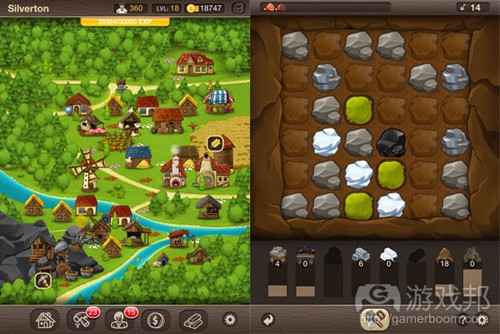
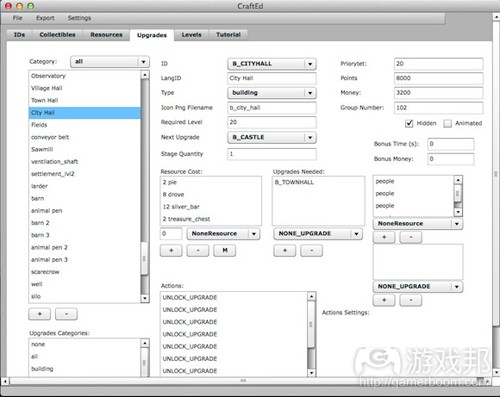
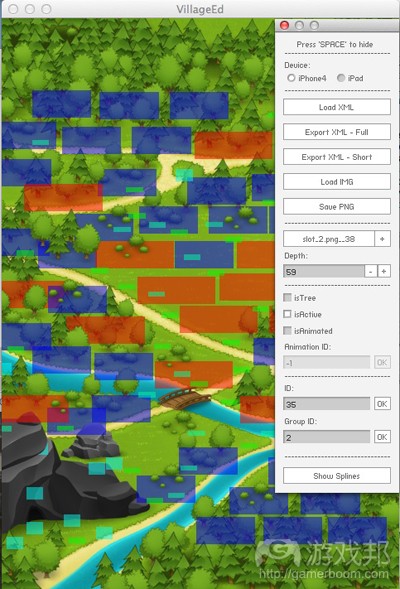
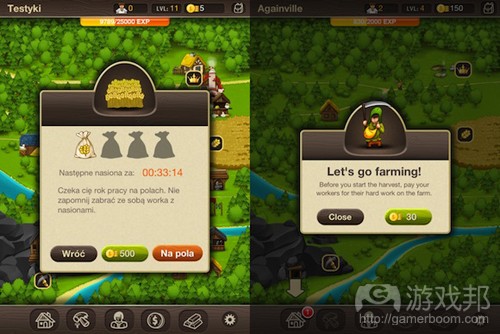



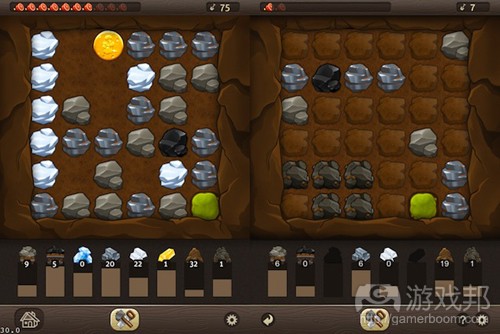
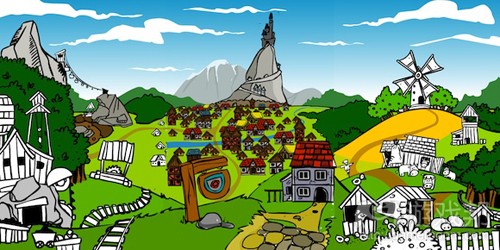

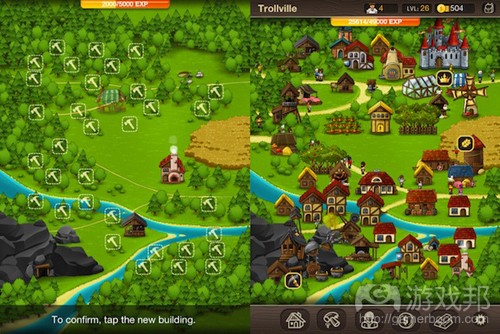
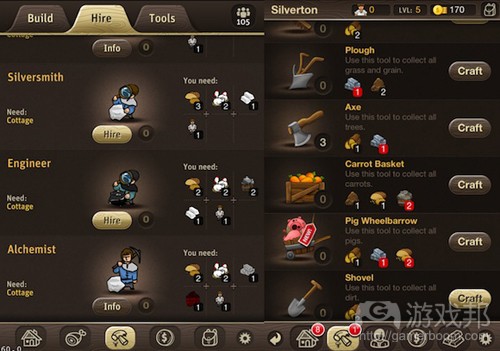

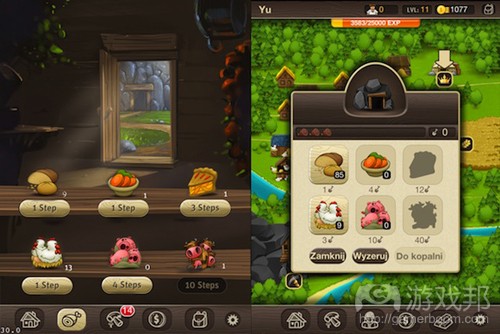
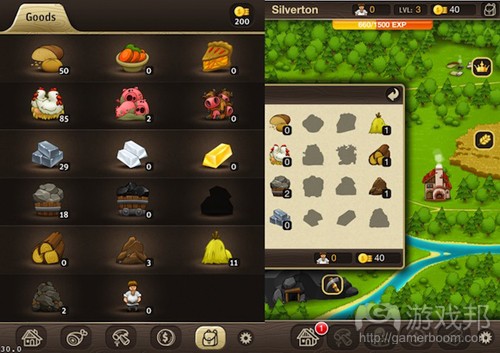
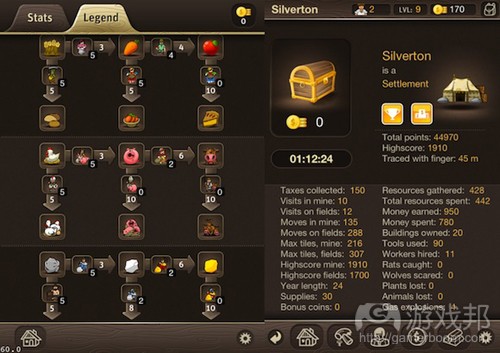
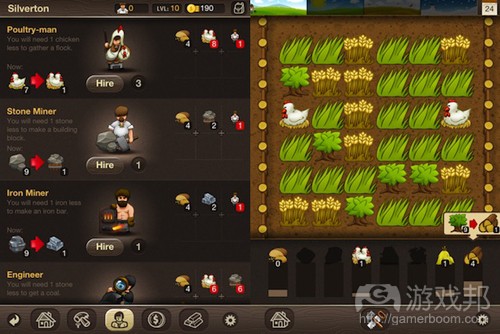

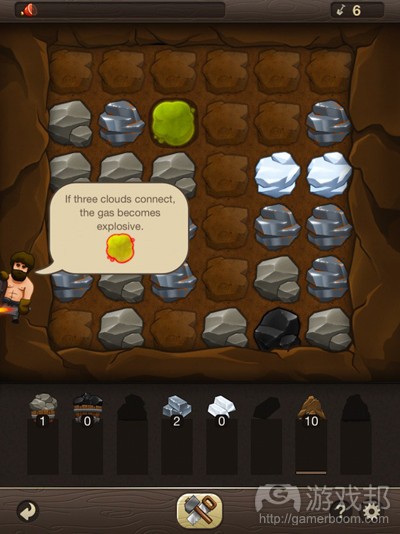
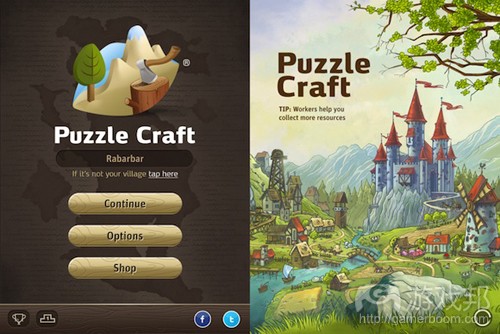
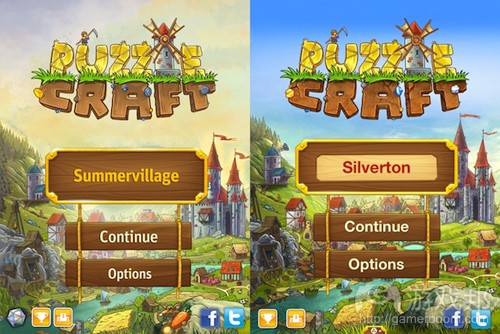

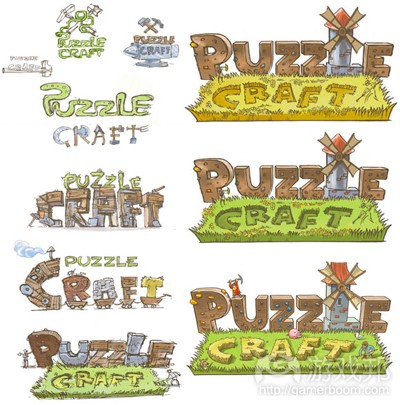














 闽公网安备35020302001549号
闽公网安备35020302001549号